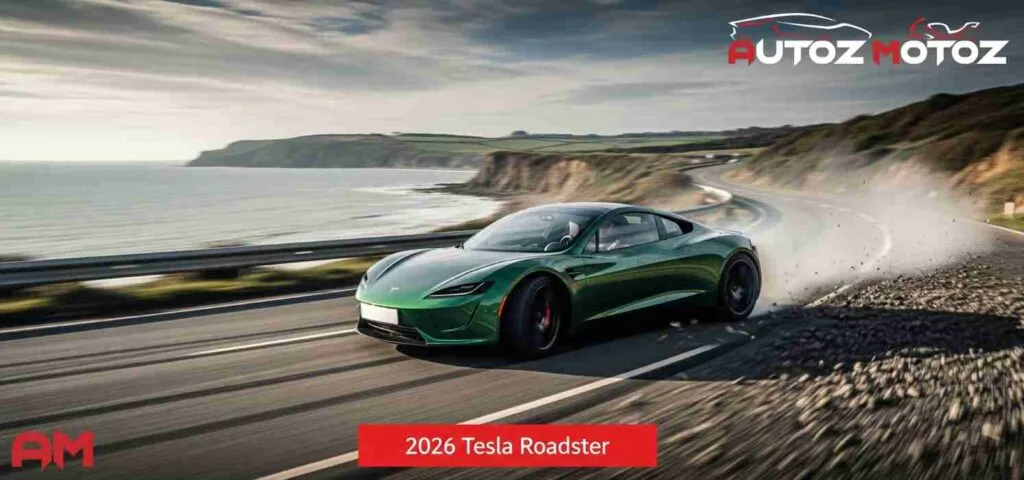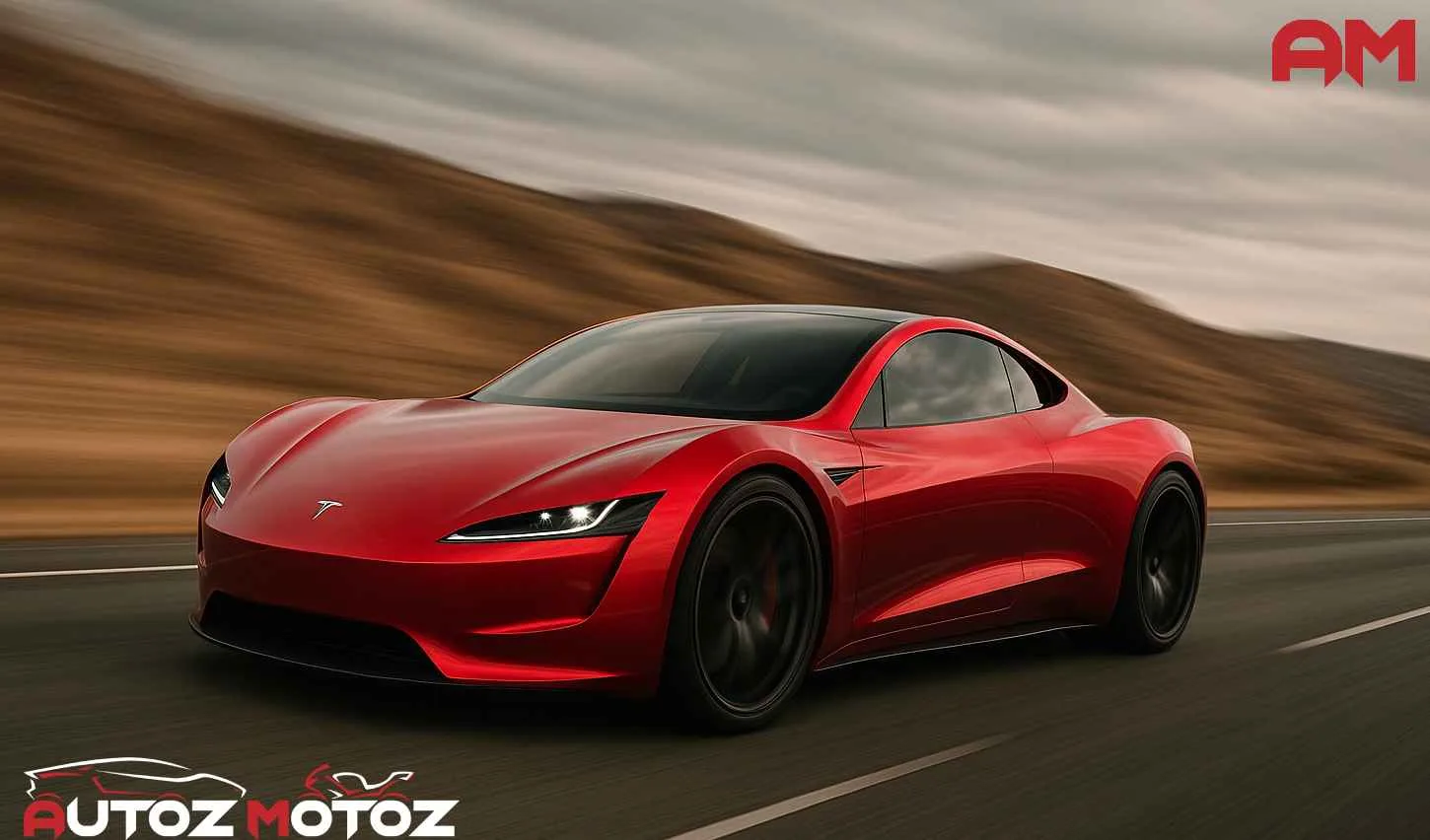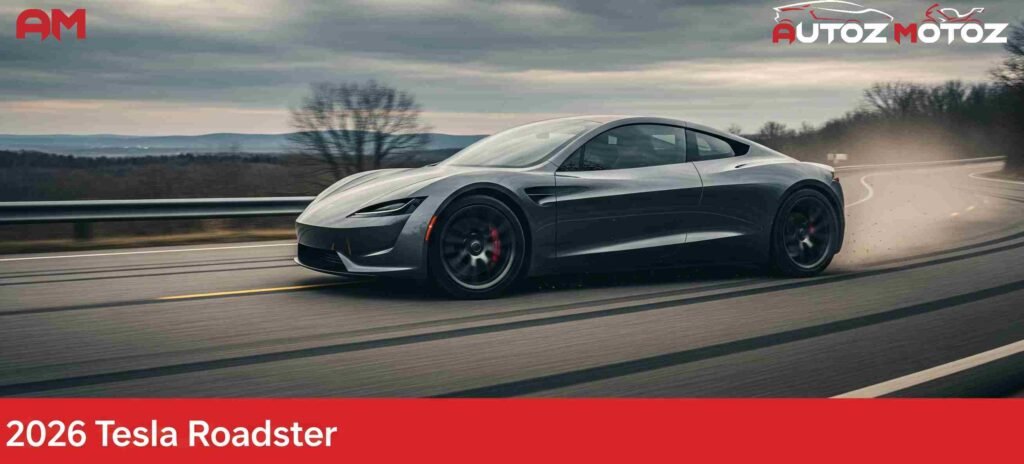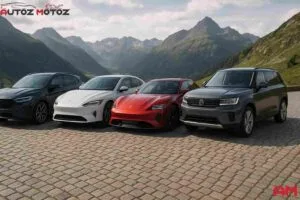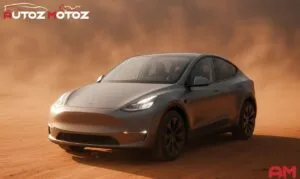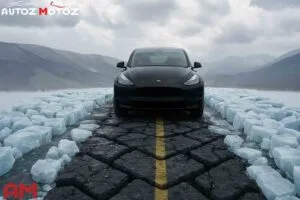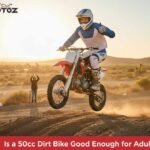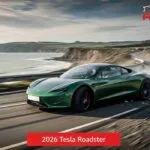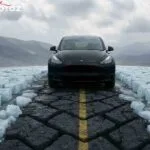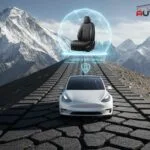“Welcome back, gearheads! Today we unveil the 2026 Tesla Roadster—an electric supercar rewriting speed, range, and reality itself. In this exclusive breakdown, we’ll decode the vehicle’s jaw-dropping specs and dive into the latest updates on its delayed release.
You’re tuned in to AutozMotoz—the voice of next-gen mobility. Let’s decode the future of performance, innovation, and electric evolution together."
Table of Contents
The Tesla Roadster isn’t just another electric car—it’s Tesla’s boldest attempt yet to shatter every expectation in the supercar world. After years of anticipation, this halo vehicle aims to deliver blistering acceleration, groundbreaking range, and aerospace – style tech all wrapped in a sleek design.
"Realistically, Tesla aims for short, thrust-assisted jumps or weight-reduction maneuvers, not flight."You may know about the previous release from here ↑|| Related : Why tesla model y is cheap?
For EV enthusiasts and performance purists alike, it matters because it could redefine what an electric hypercar truly is. With Tesla pushing the boundaries of drive systems, aerodynamics and battery technology.
Why It Matters
In a world saturated with high-end performance vehicles, the 2026 Tesla Roadster stands out as a bold declaration: electric vehicles don’t have to compromise on thrills, practicality or innovation. By combining a massive driving range with hypercar performance—and hinting at optional thruster modules from SpaceX—Tesla is offering a machine that transcends cars. For the brand and for the industry, the stakes are enormous: if this car hits its ambitious targets, rivals must play catch-up. If it falters, the hype may outpace the reality and credibility will be at risk.
Performance & The SpaceX Package
Beyond Automotive Limits
|| Related : Top 40 global car brands and new arrivals
| Performance Metric | Original Claim (2017) | Latest Claim (2024) |
| 0-60 mph | 1.9 seconds | Sub-1.0 second (with SpaceX Package) |
| Top Speed | Exceeds 250 mph | Unchanged, but potentially higher |
| Range | 620 miles | Unchanged, a major ongoing challenge |
Performance & SpaceX Package
Another figures are headline-making. Tesla’s brochure shows 0-60 mph in 1.9 seconds, top speed over 250 mph, and torque at the wheels exceeding 10,000 Nm. Tesla The optional SpaceX-inspired package takes it further: cold-gas thrusters, extra downforce and lateral thrust, possibly dropping the sprint time below 1.1 seconds. This package blurs the line between car and aerospace asset. But the physics are brutal—tire grip, thermal load and regulatory barriers all conspire to make achieving these claims extremely challenging. It’s bold, futuristic and deeply intriguing.
Musk has since ratcheted up the performance goal with the latest claim of a 0-60 mph time in less than one second. This incredible target is understood to be tied directly to the optional SpaceX Package.
| Feature | Detail |
| SpaceX Thrusters |
|
| Enhanced Dynamics |
|
| The “Flying” Concept |
|
However, the latest, more audacious claim of a 0-60 mph time in less than one second—potentially achieved with the optional SpaceX package utilizing cold-gas thrusters—is where the line between automotive and aerospace engineering truly blurs. Whether this ambitious target proves accurate, the Roadster is clearly being engineered to be the fastest production car on the planet.
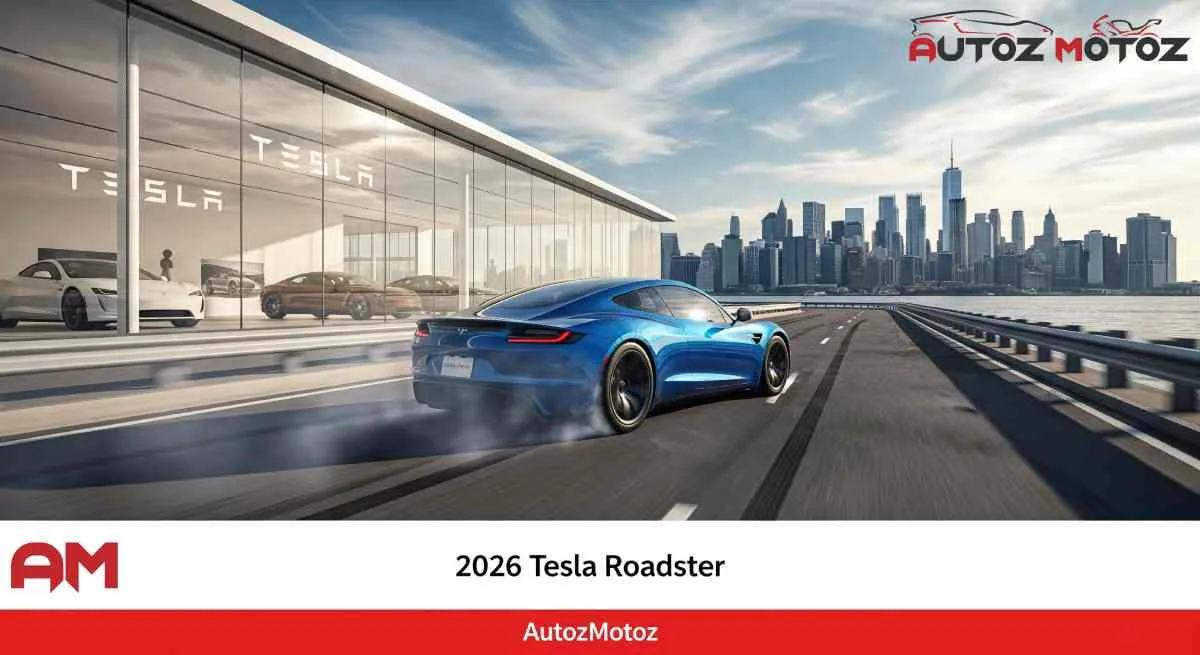
Electric Edge
The Roadster’s architecture is its most potent weapon. With a reported ~200 kWh battery pack (twice the capacity of Tesla’s current top models) and an 800 V system, the promise is 620 miles of range and ultra-fast charging. Tri-motor all-wheel drive and instant torque vectoring yield razor-sharp responses in cornering and sprinting. Simply put, the car blends endurance and speed— a rare combination. Add in aerodynamic engineering and structural battery integration, and you have a machine built not just for straight-line speed, but corridor-to-corner dominance.
|| Related : How Do Lithium-ion Batteries Compare to Other Battery Types?
4680 Architecture : Battery Used
| Item | Specification | Implication |
|---|---|---|
| → Battery Pack | ~200 kWh using 4680 cells | Twice the size of current Tesla high-end packs. |
| Voltage | 800 V system | Enables faster charging, higher power. |
| Integration | Battery forms part of chassis | Weight saving + structural benefit. |
| Charging | >350 kW target | ~200 miles in ~15 minutes (theoretical). |
Interior and Connectivity
As with all Tesla models, the Roadster’s inner section is expected to follow the brand’s signature minimalist design philosophy.
|| Especially for electric vehicle : Where to Find the Best Car Digital Multimedia Solutions?
- Seating: The new configuration is a 2+2, though the rear seats appear small and best suited for children or short trips, given the dramatic, angled roofline.
- Roof: The concept features a removable glass panel roof that can be stowed in the trunk, effectively making the car a convertible.
- Infotainment: The cabin is dominated by a large, integrated touchscreen display. Consistent with Tesla’s brand strategy, users should not expect traditional features like Apple CarPlay, Android Auto, AM radio, or SiriusXM. Instead, the system will likely offer the standard Tesla ecosystem, including:
- Onboard Wi-Fi hotspot.
- Native integration of services like Spotify.
- A suite of visual entertainment apps (Netflix, Hulu, YouTube) for use while parked and charging.
The interior section is expected to showcase Tesla’s minimalist, screen-centric approach, likely featuring a yoke steering setup similar to the Model S/X, which many hope will be part of a full steer-by-wire system for advanced digital control. The large vertical touchscreen will be the command center for everything, from navigation to the vehicle dynamics software controlling the propulsion/thruster systems.
The focus remains on Tesla’s closed ecosystem (no Apple CarPlay/Android Auto), emphasizing integrated apps and Full Self-Driving (FSD) capability. The Roadster is essentially a rolling computer, where the physical hardware is inseparable from the controlling software.
| Feature | Details | Significance |
|---|---|---|
| Seating | 2+2 layout (rear seats small) | Practicality meets supercar style. |
| Roof | Removable glass panel | Open-air touring or coupe flexibility. |
| Cockpit | Large central screen, yoke steering, minimalist controls | High-tech, Tesla-style immersion. |
| Materials | Lightweight composites, structural battery integration | Reduces weight, boosts rigidity. |
Pricing & Availability
| Model | Estimated Price | Status | Notes |
|---|---|---|---|
| Base Roadster | $200,000 USD | Reserve open | Entry-level performance spec. |
| Founders Edition | ~$250,000 USD | Limited to ~1,000 units | Priority delivery, premium trim. |
Critical Notes and Industry Skepticism
The Roadster’s extraordinary promises are met with significant professional skepticism concerning feasibility, market timing, and long-term viability.
1. The Timeline and Delay Problem
- Every time CEO Elon Musk radically increases the design goals (such as the shift from 1.9s to sub-1.0s), the car’s architecture must be re-engineered, directly contributing to the extensive delays.
- This “perfectionist delay loop” has frustrated reservation holders, highlighted recently by high-profile refund requests from early backers like OpenAI CEO Sam Altman.
2. Engineering and Physics Hurdles
- The Sub-1.0 Second Challenge: While high-performance EV competitors like the Rimac Nevera have validated 1.8-1.9 second runs, breaking the 1.0-second barrier via propulsion (the SpaceX Package) introduces massive complexity.
- Dead Weight: Competitors (like Mate Rimac, CEO of Bugatti/Rimac) note that the necessary hardware for the thrusters (tanks, compressors, nozzles) adds significant “dead weight” that reduces overall performance and efficiency when the thrusters are not in use.
- Safety and Legality: Integrating cold-gas thrusters into a street-legal vehicle creates immense regulatory and safety challenges, as the sudden burst of thrust and noise could pose risks to the car and its surroundings.
- Battery Packaging: Fitting a massive 200 kWh battery into a compact sports car chassis is an enormous technical challenge, especially while maintaining a reasonable curb weight and thermal management for hypercar performance.
3. Competition has Caught Up
- Rimac Nevera: In production, has validated numerous speed records, including a sub-2.0 second 0-60 mph time and an EV top speed record of 258 mph.
- Pininfarina Battista & Aspark Owl: Both are electric hypercars with extreme performance figures and limited production runs, priced in the $2 million+ range.
While the expected price of $200,000 – $250,000 makes it a “bargain” compared to these rivals, its continued absence from the market means it has lost the first-mover advantage, allowing rivals to refine their technology.
|| Related : Some Facts About BRAKE CYLINDER FOR CAR That Will Make You Feel Better
4. Usability and Functionality
- Infotainment & Ecosystem: Tesla’s insistence on a closed ecosystem (no Apple CarPlay/Android Auto) is a major sticking point for many high-end automotive buyers who expect robust, integrated connectivity options.
- Minimalist Design: While trendy, the extremely minimalist, screen-centric interior may not meet the expectations of luxury supercar buyers who often prioritize unique materials, bespoke craftsmanship, and intuitive physical controls.
Market Competition: Electric Hypercar Showdown
|| Related : How Under-Seat Boxes Maximize Space for Drivers : Practical Car Design
Tesla’s long delay has opened the door for several powerful competitors chart;
| Vehicle | 0-60 mph | Range | Price | Notes |
|---|---|---|---|---|
| 2026 Tesla Roadster | 1.9 s (claimed) | 620 miles | ~$200k | Ambitious targets. |
| Rimac Nevera | 1.85 s (verified) | ~300 miles | ~$2.2 M | Already in production. |
| Lotus Evija | ~3.0 s (estimate) | ~250 miles | ~$2.5 M | Lightweight focus. |
While competitors have already validated their numbers, the 2026 Tesla Roadster aims to deliver comparable performance at a fraction of the cost—if Tesla can meet its goals.
Technical & Production Challenges
Despite Tesla’s ambition, analysts highlight four major challenges for the 2026 Tesla Roadster:
Timeline Delays – Announced in 2017, now targeting 2026.
Thruster Feasibility – Integrating SpaceX tech into a street-legal car poses regulatory hurdles.
Battery Density – A 200 kWh pack may create thermal and weight constraints.
Competition – Rivals like Rimac and Battista already dominate performance records.
Still, the 2026 Tesla Roadster could become an engineering icon if even 80% of its claims prove true.

|| Related : How to Use High Pressure Car Wash Gun – Avoid EXPENSIVE Mistakes !
Manufacturing Reality
Enhanced Engine & Drivetrain
Behind the glitz is brutal engineering. A 200 kWh pack, tri-motor torque vectoring, and optional thrusters demand next-gen manufacturing. Structural battery integration complicates crash-safety certification; the SpaceX package adds regulatory and safety layers never tested in mass production. Tesla must manage thermal loads, material fatigue, and assembly precision at hypercar volume—an area where it has limited precedent. The “engine” today means electric motors, power electronics and software; Tesla’s roadmap must deliver reliability, not just headline figures. The manufacturing reality may force compromises, even if the goal remains sensational.
Timeline & Slipping
| Milestone | Original Target | Latest Status | Observations |
|---|---|---|---|
| Production Start | 2020 | Likely 2026 | Repeated delays highlight manufacturing complexity. |
| Public Demo | Late 2024 | Demo still impending | Credibility at stake. |
| Customer Deliveries | 2025 (model year 2026) | Many believe 2028+ realistic | Reservations are active for years already. |
FAQs
Q1: When will the 2026 Tesla Roadster be available?
A1: Tesla still lists a model-year 2026 date, but most industry watchers believe meaningful deliveries may occur in 2026 or later
Q2: What range does the 2026 Tesla Roadster claim?
A2: Tesla claims a driving range of up to 620 miles on a full charge.
Q3: Is the SpaceX thruster package real?
A3: Yes, Tesla has indicated an optional package with cold-gas thrusters for ultimate performance—but practical implementation and legality remain unverified.
Q4: How much will the 2026 Tesla Roadster cost?
A4: Starting price estimated around $200,000 for the base version, with a Founders Edition around $250,000.
Q5: What battery technology does the Roadster use?
A5: The car is expected to use Tesla’s 4680 cells in a ~200 kWh architecture for high energy density and structural integration.
Conclusion
The 2026 Tesla Roadster is undeniably a “halo car”—a project meant to showcase the outer limits of electric technology. If Tesla achieves even the base performance claims, it will be a monumental engineering achievement, especially at its price point.
However, the key question remains: Can Tesla transition these experimental, physics-defying claims into a mass-manufacturable, reliable, and profitable product before the competition (or a new wave of battery technology) makes the current specifications obsolete? For reservation holders who have waited years, the technical feasibility is less critical than the need for a final, concrete production and delivery date.
My assessment: the 2026 Tesla Roadster remains one of the most thrilling blueprints ever proposed for an EV hypercar. It fuses radical performance claims with cutting-edge technology—but every measure of it is accompanied by massive “ifs.” If Tesla can deliver even 80 % of the published specs, the vehicle will still rewrite the standards of electric performance. That said, the repeated timeline slips and the manufacturing demands create risk.
Tech innovator and business strategist with a foundation in Computer Science and diverse expertise in IT, marketing, and banking. Committed to building disruptive products and customer experiences that shape industries and create global market dominance.

